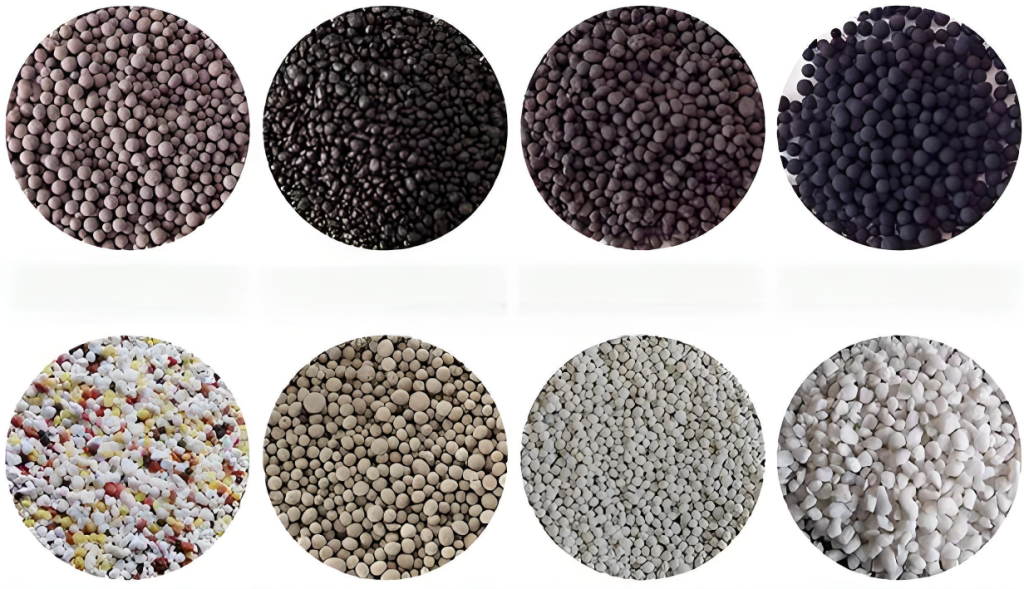Agricultural production cannot do without various fertilizers and nutrients. Fertilizers are essential nutrients for plants, which can improve soil properties and increase soil fertility levels.
Fertilizers are generally divided into organic fertilizers, inorganic fertilizers, and biological fertilizers, and can also be classified into farmhouse fertilizers and chemical fertilizers according to their sources. The types of fertilizers required for different growth stages of plants vary. Below, we will provide a detailed introduction to the characteristics and functions of common fertilizers.
What is inorganic fertilizer
Inorganic fertilizers are mineral fertilizers, also known as chemical fertilizers, abbreviated as chemical fertilizers, which include nitrogen, phosphorus, potassium, and compound fertilizers.
1. Potassium fertilizer
Function: Potassium fertilizer can promote crop photosynthesis, promote crop fruiting, and improve crop cold and disease resistance, thereby increasing agricultural yield.
Types: Industrial potassium fertilizers include potassium sulfate, potassium chloride, potassium nitrate, potassium phosphate, potassium magnesium fertilizer, potassium calcium fertilizer, etc; Other potassium fertilizers include plant ash, kiln ash potassium fertilizer, organic potassium fertilizer, etc.
2. Phosphate fertilizer
Function: Reasonable application of phosphorus fertilizer can increase crop yield, improve crop quality, accelerate tillering of grains, promote grain fullness, improve fruit yield, and increase crop sugar and oil content.
Types: According to the purchasing editor, phosphate fertilizers can be divided into natural phosphate fertilizers and chemical phosphate fertilizers based on their sources; Divided into wet process phosphate fertilizer and thermal process phosphate fertilizer according to production methods; According to solubility, it is divided into water-soluble phosphate fertilizer, weakly acid soluble phosphate fertilizer, and insoluble phosphate fertilizer.
3. Nitrogen fertilizer
Function: It is a component of amino acids in the plant body, a component of proteins, and a component of chlorophyll that plays a decisive role in photosynthesis.
Types: ammonium nitrogen fertilizer, nitrate nitrogen fertilizer, amide nitrogen fertilizer, and long-acting nitrogen fertilizer.
4. Compound fertilizer
Function: It has the advantages of high nutrient content, low side components, and good physical properties. It plays a very important role in balanced fertilization, improving fertilizer utilization efficiency, and promoting high and stable crop yields.
Types: monoammonium phosphate, diammonium phosphate, potassium dihydrogen phosphate, etc.
What is organic fertilizer
Organic fertilizers mainly come from plants and/or animals, commonly known as farmyard manure, which refers to slow-release fertilizers containing a large amount of biological substances, animal and plant residues, excrement, biological waste, and other substances.
1. Types of organic fertilizers
Agricultural waste such as straw, soybean meal, cotton meal, etc.
Animal manure, such as chicken manure, cow, sheep, horse manure, and rabbit manure.
Industrial waste such as wine lees, vinegar lees, cassava residue, sugar residue, furfural residue, etc.
Household waste, such as kitchen waste, etc.
Urban sludge, such as river sludge, sewage sludge, etc.
2. The role of organic fertilizers
Not only can it provide comprehensive nutrition for crops, but it also has long fertilizer efficiency, can increase and update soil organic matter, promote microbial reproduction, improve soil physicochemical properties and biological activity, and is the main nutrient for green food production.
3. How to use organic fertilizers
The application method can be combined with deep plowing work or by evenly spreading fertilizer in areas with concentrated root distribution (as well as in soil layers that are often kept moist) during sowing, in order to achieve the effect of soil fertilizer integration.
When using the strip ditch fertilization method, the strip ditch can be excavated in the soil first, and then sown after the fertilizer is applied to the soil; Alternatively, a soil trench can be excavated about 5 centimeters away from the fruit tree, and then fertilized.
What is biological fertilizer
It refers to the preparation of active microorganisms produced by cultivating specific microbial strains. It is non-toxic, harmless, and does not pollute the environment. Through the vitality of specific microorganisms, it can increase plant nutrition or produce plant growth hormones, promoting plant growth.
1. Types of biological fertilizers
Divide microbial fertilizers into bacterial fertilizers, actinomycete fertilizers, fungal fertilizers, algal fertilizers, and compound microbial fertilizers according to their microbial types.
Microbial inoculants and compound microbial fertilizers are classified according to their functional characteristics.
2. The role of biological fertilizers
The efficacy of microbial fertilizers is a comprehensive effect that can enhance soil fertility, improve soil structure, stimulate crop growth, improve crop quality, enhance plant disease (insect) and stress resistance, reduce the use of fertilizers, and improve fertilizer utilization efficiency.
3. How to use biological fertilizers
1. Taboos: Combination or mixing with fertilizers, pesticides, insecticides, etc.
2. Suitable for the soil and environmental conditions of the area being used.
3. There are certain requirements for temperature and moisture to avoid use in high temperature and dry conditions.
Fertilizer form

Solid fertilizer
Introduction: Fertilizers in a solid state are easier to store, transport, and apply compared to liquid fertilizers.
Types: It can be divided into granular fertilizer, powdered fertilizer, and coated fertilizer.
Usage: It can be directly sprinkled on the soil, buried under the soil, or dissolved in water before being poured into the soil, but the concentration should be noted, generally at 500 times or more.
Gas fertilizer
Introduction: Fertilizer in a gaseous state at room temperature and pressure is mainly used in greenhouses and plastic greenhouses due to its strong gas diffusion.
Type: Carbon dioxide is a commonly used gas fertilizer.
Usage: The methods for supplementing CO2 gas fertilizers include biodegradation, combustion, electrolysis, soil chemistry, and finished gas production.
Liquid fertilizer
Introduction: Also known as fluid fertilizer, it is more easily absorbed by plants and has a higher absorption and utilization rate.
Types: including fertilizers in a solution state and fertilizers containing solid particle suspensions, such as liquid ammonia, ammonia water, carbonized ammonia water, and mixed aqueous solutions (or suspensions) containing nitrogen fertilizer, phosphorus fertilizer, and potassium fertilizer (or salts).
Usage: It can be used through irrigation and spraying, which is more conducive to rapid absorption by plants.
If you have any further inquiries, please feel free to consult our company at any time.